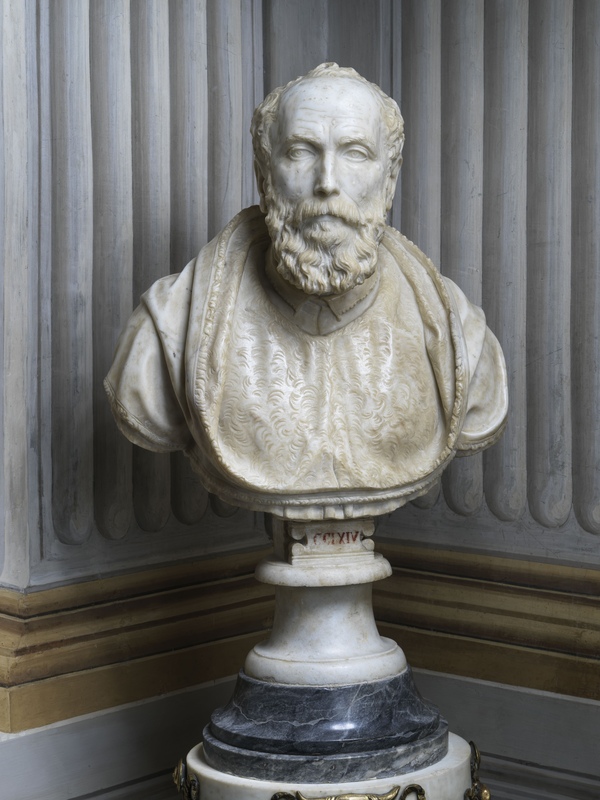Portrait of a Man
This bust portrays a bald, elderly man with a serious expression. Framed by a short beard, his face shows quite regular features. His cheeks are spotted with small raised marks, probably intended to be moles. He wears a short fur cloak whose surface is not well defined and whose hem is turned up around his neck. On the whole, the sculpture gives the impression of an unfinished work, in particular because the polishing seems imperfect in several places.
The precise identity of the subject is not known. Over time, he has come to be generically called ‘the philosopher of the 16th century’. Similarly, the circumstances of the work’s entry into the Borghese Collection are unclear. On the basis of its stylistic characteristics, critics date the sculpture to between the late 16th and early 17th centuries.
Object details
Inventory
Location
Date
late 16th century - early 17th century
Classification
Period
Medium
Dimensions
Provenance
Documented in the Borghese Collection from c.1796 (I. Faldi, Galleria Borghese. Le sculture dal sec. XVI al XIX, Roma 1954, p. 12); Inventario Fidecommissario Borghese, 1833, C, p. 46, no. 69; purchased by Italian state, 1902.
Conservation and Diagnostic
- 1997 Patrizi Maria Gigliola
Commentary
An unknown elderly man is the subject of this portrait. He is bald and has a furrowed brow. His serious gaze is directed at the observer; his head shows a slight upward incline. His nose is straight and regular, while his cheeks are sunken with age and spotted with marks that seem to be large moles. His beard is thick and short, as is his moustache. He wears a fur cloak, whose tufts seem carved rather than depicted in relief. The hem of the cloak is raised at the back and folded over at the neck, leaving visible the sleeves of the garment below. The outer edge of the cloak is characterised by curvatures of different widths, which highlight a separation between the arms and the bust of the portrayed subject. Less-than-perfect polishing of the sculpture in certain areas suggests that it may have been left unfinished.
Faldi dubiously identified the work with an entry in the 1610 inventory which indicates an unfinished portrait of Charles V (Vatican Secret Archive, Borghese Archive, 37, no. 616, Inventario delle statue antiche, colonne, tavole e pietre di vari marmi comprese nella primogenitura, 1610, no. 115, in Faldi 1954, p. 11); the description given here, however, is of a ‘head only’. It is more likely that the work in question corresponds to the mention of ‘a philosopher of the 16th century’ in the 1833 Inventario Fidecommissario (C, p. 46, no. 69), at the time on display in Room 2. Faldi had in fact also noted that Visconti’s draft for his catalogue of sculptures of the Collection referred to a ‘nice modern bust, perhaps from the 16th century’ in reference to a work held in the same room; however, this entry was not included in the definitive edition of the catalogue published in 1796 (1954, p. 12).
The circumstances and date of the sculpture’s entry into the Borghese Collection are not known; it has also been impossible to identify the subject of the portrait. In light of the compact rendering of the garments, the man’s expression and the careful attention devoted to the face, the bust can be dated to between the late 16th and early 17th century. The fur cloak also suggests this same chronology, given that it is represented in a number of portraits of ecclesiastics, such as monsignors (Cristoforo Stati, Francesco Barberini, 1613, in S. Andrea della Valle) and clergymen (Giuliano Finelli, Bust of Girolamo Manili, 1634, in the Basilica of Saint Mary Major), as well as of laypersons (Nicolas Cordier, Silvestro Aldobrandini, 1604, in church of Santa Maria sopra Minerva).
Today the sculpture is displayed in the entrance hallway of the Galleria, together with a bust of a veiled woman from the 1st century (inv. no. CCLVII), which forms its pendant. It rests upon a granite column (inv. no. CCLXIVa) with white marble cymatium moulding, which contains a gilded bronze decoration with a bucranium, garlands and paterae. Together with 15 other similar ones, the column was executed by Luigi Valadier in 1780: today only four are still present in the Galleria, the others having gone lost after they were transferred to Paris in 1810.
Sonja Felici
Bibliography
- I. Faldi, Galleria Borghese. Le sculture dal sec. XVI al XIX, Roma 1954, pp. 11-12, cat. 4.
- P. Moreno, C. Stefani, Galleria Borghese, Milano 2000, p. 210, fig. 9.
- Scheda di catalogo 12/01008625, L. Russo 1983; aggiornamento S. Felici 2020.


